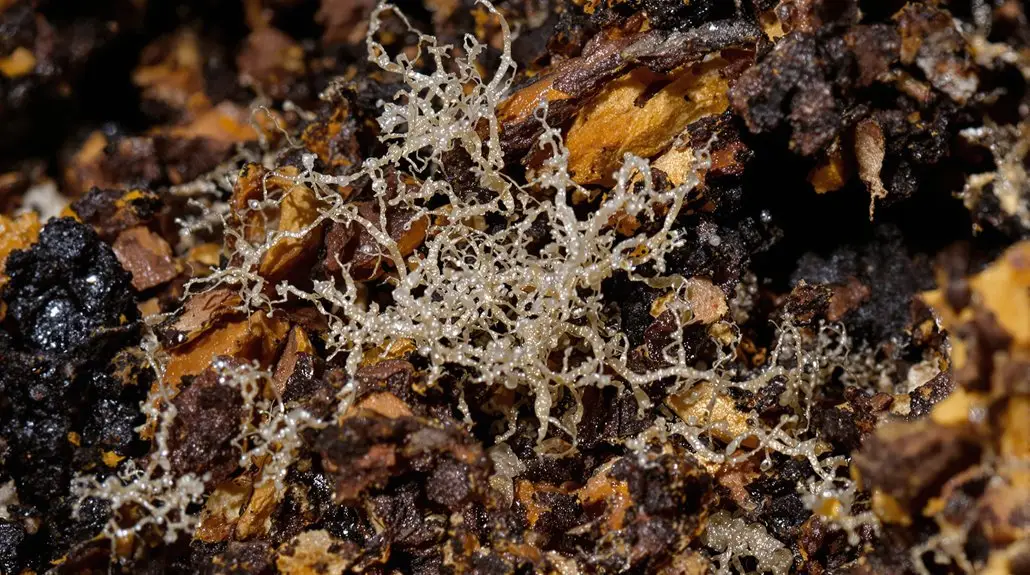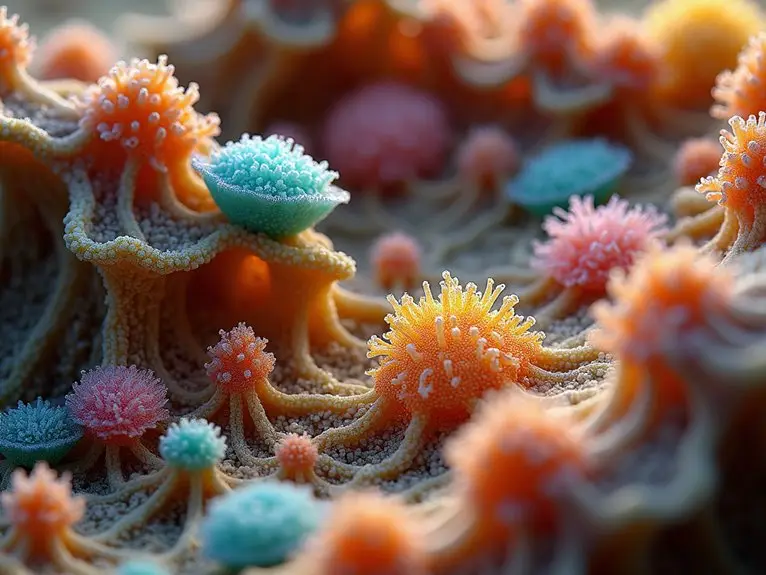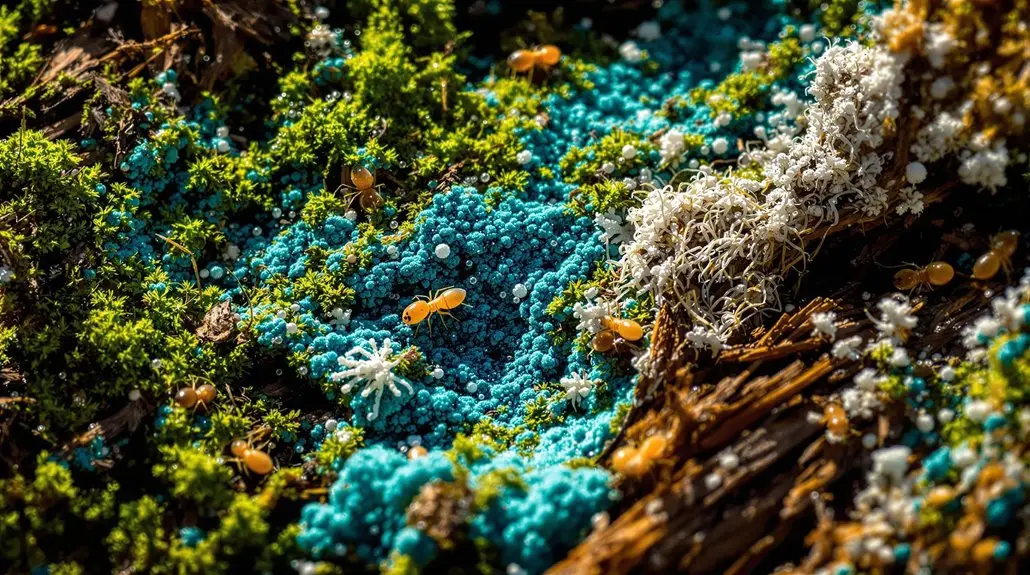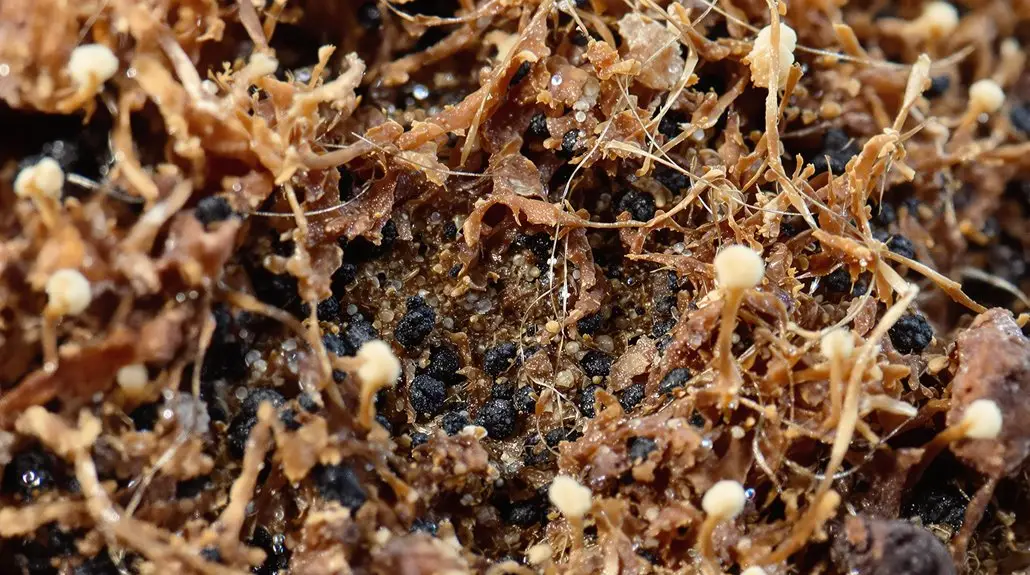The rich microbial community associated with the nest material of Reticulitermes flavipes enhances the structural integrity of the nest while contributing to disease resistance. Researchers, including Thomas Chouvenc, Monica L. Elliott, and Nan-Yao Su, found that the diverse microorganisms, such as Actinobacteria and Rhizobiales, play significant roles in organic breakdown and pathogen suppression. This dynamic ecosystem supports the colony's health and resilience, highlighting the complex interactions that sustain termite populations in their environments. Further exploration reveals even more fascinating details.
Key Insights
- Reticulitermes flavipes nests host diverse microbial communities shaped by the termites' activities and ecological roles.
- Microbial populations in these nests differ significantly from those in termite-free environments, fostering unique biodiversity.
- Beneficial bacteria, including Actinobacteria and Rhizobiales, play crucial roles in nutrient breakdown and pathogen suppression within the nests.
- Environmental factors like temperature and humidity influence microbial dynamics, affecting the overall health and behavior of termite colonies.
- Research into these microbial communities can lead to innovations in antibiotic discovery and sustainable pest management strategies.
Termite Nest Composition and Function

Termite nests, which serve as essential habitats for entire colonies, are composed of a combination of inanimate materials and the termites themselves, showcasing remarkable construction techniques that vary across species. The inanimate components include faeces, partly digested plant material, and soil, with faeces being particularly valued due to their desirable properties as a construction material. These nests provide essential protection against environmental threats, such as desiccation, light, pathogens, and predators. They facilitate ventilation and cooling, ensuring efficient movement within the nest. Additionally, the structure of these nests can be specialized for various activities, including food storage and fungus cultivation, allowing termites to adapt their living space according to their ecological needs and environmental challenges. Furthermore, termites play a crucial role as decomposers of decaying plant material, significantly contributing to nutrient cycling in their ecosystems. To protect against potential infestations, pre-construction termite services can offer comprehensive termite protection, ensuring the longevity and safety of structures built in areas prone to termite activity.
Diversity of Microorganisms in Termite Nests

Microbial communities thriving within termite nests showcase remarkable diversity, shaped by a variety of factors including the species of termites present and their ecological roles. These nests not only support unique microbial populations but also differ considerably from those found in termite-free environments. The activities of termites, such as producing antifungal compounds, influence the composition of bacterial communities, impacting their overall diversity. Additionally, certain environmental conditions within the nests can enhance this diversity.
Microbial diversity in termite nests is influenced by termite species and their activities, creating unique ecosystems distinct from surrounding environments.
- Termite engineering alters soil microbial diversity, potentially filtering rare species. Professional treatment is essential for maintaining healthy termite colonies and their associated microbial communities.
- Specific bacterial lineages, like Rhizobiales and *Actinobacteria*, are often more prevalent in nests.
- Microbial communities in termite nests contribute to essential processes, such as nutrient cycling. Moreover, the presence of mutualistic microbial symbionts within these nests plays a crucial role in enhancing nutrient availability for the termite colonies.
Role of Microbial Communities in Disease Resistance

Microbial communities in termite nests play an essential role in disease resistance, primarily through the functions of beneficial bacteria that help suppress harmful pathogens. By creating a protective environment and producing antimicrobial compounds, these microorganisms not only enhance the survival of termites but also contribute to overall colony health. Understanding the mechanisms behind pathogen suppression can provide valuable insights into the mutualistic relationships that exist within these complex ecosystems. The presence of Streptomyces species in these nests offers significant survival advantages against pathogens like Metarhizium anisopliae.
Beneficial Bacteria Functions
As researchers explore the intricate relationships within ecosystems, they uncover that beneficial bacteria in termite nests play essential roles in disease resistance, thereby enhancing the survival of these complex societies. The presence of these microorganisms contributes notably to maintaining the health of termite colonies. For instance, Actinobacteria not only facilitate the breakdown of organic material but also produce compounds that protect against pathogens. Additionally, gut symbionts enhance nutrient acquisition while indirectly defending termites from harmful microbes. Moreover, the presence of Rhizobiales fosters ecological resilience by fixing nitrogen, which is vital in nutrient-poor environments. Notably, microbial communities in termite guts differ from those in soil and wood, emphasizing their unique contributions to the termite ecosystem.
- Actinobacteria exhibit diverse metabolic activities, aiding in organic material recycling.
- Gut symbionts contribute to healthy digestion, indirectly shielding termites from pathogens.
- Rhizobiales enhance the nutrient cycle, promoting colony health.
Pathogen Suppression Mechanisms
While various factors contribute to the resilience of termite colonies against diseases, the role of beneficial bacteria within their nests is particularly significant in pathogen suppression. These microbes, especially the Streptomyces bacterium, produce antimicrobial compounds that inhibit pathogen growth. By using fecal nest material, termites cultivate these beneficial microbes, which enhance their disease resistance. This complex interaction highlights the potential for discovering new antibiotics from microbial communities in termite nests, although previous attempts to utilize these microbes for termite control have faced challenges. Understanding these mechanisms can inform future research on microbial applications in pest management. Additionally, the enhanced reliability of microbial biocontrols allows for more opportunities to suppress pathogens under unfavorable conditions.
| Microbial Function | Impact on Pathogens |
|---|---|
| Antimicrobial Compound Production | Suppresses pathogen growth |
| Nutrient Competition | Deprives pathogens of essential nutrients |
| Microbial Cultivation | Enhances colony disease resistance |
Impact of Temperature on Microbial Community Dynamics
Temperature plays an essential role in shaping the dynamics of microbial communities within termite nests, influencing both their composition and functional capabilities. As temperatures fluctuate, microbial communities adapt, affecting their interactions and overall performance.
- Warmer temperatures can enhance the activity of these microbial communities, potentially increasing wood decay rates. Additionally, invasive termite species may thrive in these warmer conditions, further complicating the ecological relationships within their nests. This increased activity can also lead to a higher likelihood of chemical exposure to harmful substances in the environment.
- The sensitivity of these communities to temperature changes varies among species, impacting their distribution within termite nests.
- Climate change is projected to alter these dynamics further, expanding termite habitats and subsequently affecting microbial relationships.
These interactions highlight the intricate balance between temperature and microbial dynamics, underscoring the significance of understanding how thermal conditions affect both termites and their associated microbial communities. This knowledge is vital for predicting ecological outcomes in changing environments.
Environmental Factors Influencing Termite Nesting Behavior
Understanding the environmental factors that influence termite nesting behavior is essential for comprehending their ecological roles and impacts on ecosystems. Temperature plays a critical role, as termites thrive at favorable growth temperatures between 75°F and 95°F. Humidity greatly affects nesting; termites prefer moist environments, which guide their nest location and structure. They often select sites near water sources, and excessive moisture can enhance infestation risks, particularly in poorly drained areas. Geographical influences, including climate and soil conditions, dictate termite species distribution, with tropical regions offering ideal habitats. In addition, termites exhibit adaptive strategies in their nesting architecture to maintain stable internal environments, demonstrating their versatility in response to varying ecological conditions. Seasonal patterns of termite activity indicate that termite nesting behaviors are particularly pronounced during spring and summer months when environmental conditions are most favorable. Furthermore, drywood termite spot treatments can effectively manage infestations without the need for extensive structural modifications.
Potential Applications of Termite Microbiota Research
Exploring the potential applications of termite microbiota research opens up exciting avenues in fields such as antibiotic discovery and biological control strategies. By studying the unique microbial symbiosis within termite nests, researchers are uncovering novel compounds that could lead to the development of new antibiotics, offering solutions to antibiotic resistance. Additionally, insights gained from these microbial communities may enhance biological control methods in agriculture, promoting sustainable practices and reducing reliance on chemical pesticides. Understanding the termite gut microbiomes involved in lignocellulose degradation could further contribute to the discovery of new biotechnological applications and environmentally friendly solutions. Furthermore, the use of eco-friendly Bora Care treatments showcases how termite research can influence pest management practices, minimizing disruption and promoting safety.
Antibiotic Discovery Potential
- Identifying new antibiotics from secondary metabolites of fungal isolates.
- Exploring the complex interactions within termite ecosystems to inform antibiotic development.
- Leveraging the unique microbial diversity for innovative medical applications.
- These findings suggest that termites could play a vital role in the future of antibiotic discovery.
- Additionally, the role of gut microbiota in enhancing termite immunity may provide insights into novel antimicrobial strategies.
Biological Control Strategies
While the potential for antibiotic discovery within termite microbiota is remarkable, the applications of this research extend further into the domain of biological control strategies. Termites are susceptible to various pathogens; however, their symbiotic microbes often neutralize these threats, providing a natural defense mechanism. Understanding the microbial dynamics in termite nests can inform eco-friendly control methods, such as manipulating nutrient availability or identifying microbiome signatures. Additionally, while fungal pathogens like *Metarhizium anisopliae* and *Beauveria bassiana* are commonly used, their effectiveness may be limited due to termite symbionts. Consequently, exploring viral and bacterial pathogens, alongside advances in genomic and metagenomic technologies, could lead to innovative and sustainable termite management solutions that disrupt harmful microbial relationships without relying on traditional chemicals. Termites employ defense strategies to prevent harmful microbiological growth in nests, which could be crucial for enhancing biocontrol approaches.
Microbial Symbiosis Insights
Understanding the intricate relationships between termites and their microbial symbionts reveals significant potential for advancing biotechnological applications, particularly in biomass conversion. The diverse gut microbiomes of termites, including bacteria such as Spirochaetes and Fibrobacteres, play essential roles in breaking down lignocellulose, which consists of cellulose, hemicellulose, and lignin. This process not only enhances the efficiency of biomass conversion but also contributes to ecosystem fertility through carbon and nutrient cycling.
- Microbial community engineering can optimize lignocellulose degradation in controlled environments.
- Anaerobic bioreactors allow the study of termite microbiota, maximizing carboxylate production from lignocellulosic materials.
- Understanding lignin degradation pathways can improve bioconversion processes in biorefineries, offering innovative solutions for sustainable energy sources. Additionally, research has shown that up to 37% lignin removal can be achieved by termite gut microbiomes, highlighting their effectiveness in lignocellulose degradation.
Future Directions in Termite-Microbe Interaction Studies
As researchers explore deeper into the complexities of termite-microbe interactions, they are increasingly employing advanced omic technologies—such as genomics, proteomics, and metabolomics—to unravel the intricate relationships and functional dynamics of microbial communities within termite guts. Future studies can enhance our understanding of biochemical processes, microbial diversity, and ecological impacts. Additionally, understanding the host-microbe interactions in lignocellulolytic systems could provide valuable insights into optimizing bioconversion processes. The use of subterranean termite baiting stations can also influence microbial community structures by altering the habitat and food sources available to termites.
| Research Focus | Potential Outcomes |
|---|---|
| Biochemical Processes | Improved biofuel production |
| Microbial Diversity | Enhanced nutrient cycling |
| Ecological Impact | Better soil health management |
This approach can lead to innovative biotechnological applications, such as enzyme engineering and sustainable energy solutions, presenting exciting prospects for both ecological health and industrial advancements. Researchers are poised to uncover new insights into these essential interactions.
Final Thoughts
In the intricate world of termite nests, the microbial community acts as a hidden ally, much like a knight defending its castle. This rich diversity not only supports the termites' health but also plays a significant role in disease resistance, adapting to environmental challenges. As researchers explore deeper into these interactions, they uncover potential applications that could revolutionize our understanding of ecosystem dynamics.
Discovering the Hidden Allies in Termite Nests
Ultimately, the study of termite microbiota opens new avenues for exploration, reinforcing the essential connections within nature.
Unlocking Nature's Secrets: The Future of Pest Control
At NaturePest Holistic Pest Control, we believe in harnessing the power of these incredible microbial communities to provide sustainable pest control solutions. Located in South Florida, we invite you to join us in discovering how these natural allies can help maintain a balanced ecosystem. Explore our services today and take a step towards a healthier environment!



